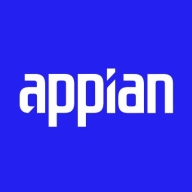

Appian and Microsoft Power Apps are key players in the competitive low-code development space. Appian stands out with its advanced features in low-code development and process design, while Power Apps excels at easy integration with Microsoft products, offering stronger connectivity for Microsoft ecosystem users.
Features: Appian offers rapid development capabilities with its cohesive architecture, supporting complex business workflows and seamless case management. The platform allows the creation of social, collaborative platforms that streamline process modeling. Power Apps provides a highly customizable platform with easy integration into Microsoft products and seamless data connectivity, facilitating quick app development with diverse application opportunities.
Room for Improvement: Appian needs growth in UI customization and offline capabilities, with better adaptability for complex projects and DevOps integration. Power Apps requires enhancements in advanced workflow functionality and integration with non-Microsoft systems. Both platforms could improve in error handling and performance.
Ease of Deployment and Customer Service: Appian offers versatile deployment options, including hybrid and on-premises models, ideal for enterprises with varied infrastructure needs. Power Apps focuses on extensive cloud solutions, enhancing accessibility. Appian is known for excellent customer service, though technical support can be inconsistent. Power Apps benefits from a large user community for support, despite average customer service.
Pricing and ROI: Appian, while generally more expensive, delivers significant ROI due to its robust process automation and integration features, beneficial for enterprises seeking comprehensive solutions. Power Apps offers competitive pricing with substantial value for existing Microsoft users but can become costly with premium features. Evaluating total costs and ROI is crucial for both platforms.
Appian is very efficient, allowing us to build a lot of applications within a financial year, making it cost-effective.
The connection between Power Apps and Power BI simplifies generating and presenting reports, alleviating the workload and enhancing productivity.
The aim is to create a cleaner interface to replace spreadsheets, thus standardizing processes and improving efficiency.
Their customer service is responsive, and the team is very prompt for support.
The technical support is generally good.
Appian has a community where I can put my questions.
Their assistance was crucial as we developed the solutions.
Microsoft's technical support is around a seven to eight.
Appian is scalable, but it depends on how you build your applications.
Initially, without much coding, I can easily handle five thousand records.
If it is flexible and includes premium connectors, scalability is easy.
It depends on how it has been designed and how it has been configured.
I would rate the stability of Microsoft Power Apps as a nine out of ten.
I would like to see more enhancement in the user interface to allow more freedom in designing the sites and pages.
If there is a very complex process that includes a lot of data transitioning and memory-centric processes, it consumes a lot of memory.
These tools should be intuitive for business users who will need at least a week of training to use them effectively.
This would assist business process users who lack coding knowledge.
The integration of Microsoft's autonomous AI agents would be an excellent enhancement for Power Apps.
On the pricier side, both Appian and Pega are enterprise-level solutions, placing them on the slightly higher side.
The pricing of Appian is based on the number of users and generally ranges from 70 to 100 USD per user per month.
For small to medium enterprises, it is affordable, especially with Microsoft Enterprise licensing.
For more elaborate work, an upgrade to an enterprise license, costing around $35 per license, is needed.
The zero-code integration feature is remarkable, allowing for ease of data transfer and workflow enhancement.
I can create tables, perform database-related activities, and create multiple tables.
It is easy for me to define the process and create configurable workflows.
It integrates seamlessly with Power Automate for process automation and connects with email, SharePoint, Power BI, and MS Teams, facilitating everyday processes.
The most valuable features for us are predominantly on the user interface front.
The solutions are easily integrated with other Microsoft products.


Appian is a unified low-code platform and solution used by businesses to build enterprise applications and workflows. This product adapts to the needs of clients and the technologies they are already using to combine their data in a single workflow and maximize resources. The platform has four main components through which it transforms the work process for companies of various sizes. They are:
Appian is utilized across a diverse set of industries, including automotive and manufacturing, energy and utilities, education, financial services, telecom and media, transportation, retail, insurance, healthcare, and life sciences. The most frequent use cases of Appian are customer journey, governance, risk and compliance, operational efficiency, supply chain, distributed order management, and environmental, social, and governance (ESG) management.
Appian Features
Appian has various features that allow users to create solutions for their businesses. These features can be separated into a few groups according to function, including automation, low-code application development, and integrations and data. Some of the most frequently used features of Appian include:
Appian Benefits
The benefits of using Appian include:
Reviews from Real Users
A practice leader - digital process automation at a computer software company values Appian highly because the product is easy to develop, low-code, and has a good user interface.
Alan G., an advisory board member at Codecon VR, Appian offers a clear application life cycle, easy to learn documentation, and comes with a fundamentals course.
Microsoft Power Apps is a rapid application development software and low-code development platform. The solution consists of a suite of apps, services, connectors, and a data platform. It provides an environment for building custom apps which is suitable for different businesses.
Microsoft Power Apps allows users to not only build applications, but also connect them to Microsoft's other sources, including the underlying data platform Microsoft Dataverse, as well as online and on-premise sources such as SharePoint, Dynamics 365, and Microsoft 365. The applications built using Microsoft Power Apps have a responsive design that makes them suitable for work in browsers and on mobile applications on different devices.
The no-code side of the product makes it suitable for complete beginners to app building, allowing them to easily create fully functional applications with many features. The solution also has a specialized platform for developers where specialists can access data and metadata, create custom connectors, integrate with external data, and apply business logic. The solution allows users to create three types of apps: canvas, model-driven, and portal. They are made using:
Microsoft Power Apps Features
The three different design tools of the solution, Power Apps Studio, App Designer, and Power Apps Portals Studio, come with various features which allow users to utilize the tools. Some of these features include:
Microsoft Power Apps Benefits
The product brings various benefits to organizations and individuals who utilize it. Some of the biggest advantages of Microsoft Power Apps include:
Reviews from Real Users
An IT Specialist (INFOSEC) at a government appreciates this tool because it is low-code, low learning curve, and reduces manpower.
Rafael T., a data engineer at NTT Security, likes Microsoft Power Apps, because it is great for making apps quickly, has helpful support, and integrates with Power BI.
We monitor all Rapid Application Development Software reviews to prevent fraudulent reviews and keep review quality high. We do not post reviews by company employees or direct competitors. We validate each review for authenticity via cross-reference with LinkedIn, and personal follow-up with the reviewer when necessary.